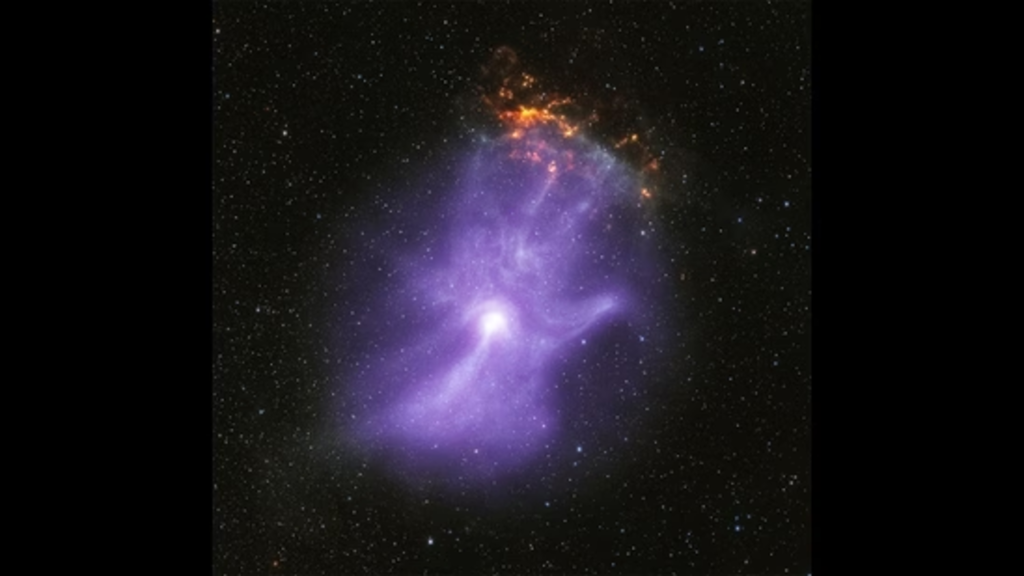In a remarkable display of celestial beauty and scientific discovery, NASA has shared breathtaking images of a cosmic ‘hand’ with ‘bones’ that was captured by their X-ray telescopes, Chandra and IXPE. This cosmic spectacle, resembling a skeletal hand with four fingers gracefully dancing amidst vibrant purple plumes, is an astonishing revelation from the universe. Located 16,000 light-years away from Earth at the base of the ‘palm,’ this ‘hand’ belongs to the enigmatic pulsar wind nebula known as MSH 15-52. In this article, we will delve into the mesmerizing imagery, the scientific significance, and the cosmic wonders surrounding this cosmic ‘hand.’
The Birth of a Cosmic Hand
At the heart of this cosmic spectacle lies a pulsar wind nebula, and to understand it better, we must first comprehend what a pulsar is. Pulsars are remnants of massive stars that have exhausted their nuclear fuel and collapsed in on themselves, forming incredibly dense objects known as neutron stars. These neutron stars often possess potent magnetic fields and subsequently evolve into pulsars, characterized by their rapid rotation and intense emission of electromagnetic radiation, including X-rays.
When young pulsars are born, they unleash jets of matter and antimatter emanating from their poles, accompanied by a powerful and energetic wind. This phenomenon leads to the formation of a pulsar wind nebula, which is a mesmerizing structure in the cosmos. To grasp the essence of this spectacle, we turn our attention to the particular pulsar at the heart of this story, the PSR B1509-58.
The Pulsar That Resembles a Hand
Nasa’s Chandra X-ray Observatory first observed the pulsar PSR B1509-58, and the images it captured are nothing short of astounding. This pulsar resembles a human hand, with its ‘fingers’ extending gracefully into space, surrounded by vibrant purple plumes that create an otherworldly ambiance. The pulsar, located at the base of the nebula, is situated a staggering 16,000 light-years from Earth, making it a distant but captivating subject of study.
The Astonishing Imagery
NASA did not merely capture static images of this cosmic ‘hand,’ but they also released a mesmerizing video that brings this celestial wonder to life. The video, titled “Quick look: X-ray telescopes reveal the ‘bones’ of a ghostly cosmic hand,” is shared on NASA’s Chandra X-ray Observatory YouTube channel. In the video’s description, the observatory notes, “A cosmic ‘hand’ has been X-rayed in a new image from NASA. NASA’s Chandra and IXPE telescopes joined forces to capture this remarkable image. MSH 15-52 is a cloud of energetic particles that resembles a human hand. Astronomers use these X-ray data to learn more about how objects like this form.”
These images and videos are not just a testament to the advanced capabilities of NASA’s X-ray telescopes but also a gateway into understanding the mysteries of the cosmos and how celestial structures like MSH 15-52 come into being.
The Cosmic ‘Hand’ and Its Significance
While the imagery itself is captivating, it is the scientific significance of this discovery that truly shines. Roger Romani of Stanford University, California, who led the study, provides an insight into what these images reveal: “The charged particles producing the X-rays travel along the magnetic field, determining the basic shape of the nebula, like the bones do in a person’s hand.” This analogy highlights the role of magnetic fields in shaping the nebula, a fundamental aspect of its structure.
The use of X-rays in this context is particularly intriguing. Most of us are familiar with X-rays as a diagnostic medical tool for humans, but here, they are harnessed in a completely different manner to uncover information that would otherwise remain hidden from our view. The X-ray data captured by Chandra and IXPE open a window to the universe’s hidden wonders, unveiling the intricate details of celestial objects like MSH 15-52.
The Beauty of Scientific Discovery
This remarkable discovery not only exemplifies the awe-inspiring beauty of the cosmos but also underscores the essential role of scientific exploration and curiosity in unraveling the mysteries of the universe. The collaboration of technology, human ingenuity, and a relentless quest for knowledge has led to the unveiling of this cosmic ‘hand’ and the insights it provides into the formation of celestial structures.
As humans, we are inherently drawn to the grandeur and magnificence of the universe. The intricate dance of stars, the birth and death of galaxies, and the enigmatic pulsars all serve as a testament to the wonders that await our exploration. This cosmic ‘hand,’ with its ‘bones’ formed from the interplay of magnetic fields, charged particles, and the remnants of a long-dead star, is a poignant reminder of our connection to the cosmos.

Scientific Significance of MSH 15-52
To truly appreciate the significance of MSH 15-52 and the cosmic ‘hand,’ it is crucial to delve deeper into the science behind this phenomenon. MSH 15-52 is a pulsar wind nebula, which is a fascinating cosmic structure created by the birth of a pulsar. Understanding the inner workings of these celestial wonders is vital for astronomers and astrophysicists.
Pulsars are the remnants of massive stars that have undergone a supernova explosion. As these stars exhaust their nuclear fuel, they gravitate inwards, forming incredibly dense neutron stars. Neutron stars are so dense that a teaspoon of their material would weigh billions of tons on Earth. These neutron stars often possess immensely powerful magnetic fields, and they rotate rapidly, emitting beams of electromagnetic radiation, including X-rays, along their magnetic axes.
The birth of a pulsar is a dynamic and violent process. When a massive star reaches the end of its life cycle, it undergoes a supernova explosion, releasing an enormous amount of energy and creating a neutron star at its core. The magnetic fields of the neutron star play a crucial role in shaping its surroundings and the emission of high-energy radiation.
As the pulsar spins, it emits intense beams of electromagnetic radiation from its magnetic poles. These beams act like cosmic lighthouses, sweeping across the cosmos as the pulsar rotates. When these beams intersect with Earth, they are detected as pulsar signals, providing astronomers with valuable insights into the properties and behavior of these cosmic powerhouses.
The magnetic fields of pulsars are incredibly strong, and they can have a profound influence on their surroundings. As charged particles are funneled along these magnetic fields, they create intricate structures and emissions that astronomers can observe and study. In the case of MSH 15-52, the charged particles following the magnetic field lines have given rise to the spectacular ‘bones’ of the cosmic ‘hand.’ These particles, in their intricate dance, create the visually striking features that NASA’s X-ray telescopes have captured.
Implications for Astrophysics
The study of pulsar wind nebulae like MSH 15-52 is not only aesthetically captivating but also holds profound implications for astrophysics and our understanding of the universe. Here are some key takeaways:
- Magnetic Fields in Cosmic Structures: MSH 15-52 provides a visual representation of the influence of magnetic fields in shaping cosmic structures. Understanding how magnetic fields interact with charged particles and influence the evolution of pulsar wind nebulae is essential in unraveling the dynamics of the universe.
- Pulsar Behavior: The imagery and data from MSH 15-52 offer valuable insights into the behavior of pulsars and their interaction with their surroundings. This knowledge contributes to our understanding of the life cycles of massive stars and the processes that lead to the formation of pulsars.
- Advanced Telescope Technology: The successful capture of such detailed and intricate images is a testament to the capabilities of NASA’s advanced X-ray telescopes. These telescopes play a pivotal role in expanding our understanding of the cosmos, pushing the boundaries of what we can observe and learn.
- Inspiring Scientific Exploration: The captivating imagery of the cosmic ‘hand’ serves as a source of inspiration for scientific exploration and discovery. It reminds us of the countless mysteries that the universe holds and the importance of continued scientific research and innovation.
Conclusion
In the vast expanse of the cosmos, where stars are born, evolve, and meet their spectacular ends, there exist enigmatic structures like pulsar wind nebulae. MSH 15-52, with its striking resemblance to a cosmic ‘hand’ with ‘bones,’ stands as a testament to the intricate interplay of magnetic fields, charged particles, and the remnants of massive stars.
The imagery captured by NASA’s Chandra and IXPE X-ray telescopes not only enchants us with its celestial beauty but also unveils the hidden secrets of the universe. These images provide a glimpse into the behavior of pulsars, the role of magnetic fields in shaping cosmic structures, and the advancements in telescope technology that enable us to explore the cosmos in unprecedented detail.
In a world filled with breathtaking cosmic wonders, the ‘hand’ of MSH 15-52 reminds us of the boundless curiosity and ingenuity of humanity, driving us to unveil the mysteries of the universe and appreciate the beauty of scientific exploration. As we continue to gaze at the stars and unravel the secrets of the cosmos, the cosmic ‘hand’ remains a vivid and captivating testament to the wonders that await us beyond our world.


